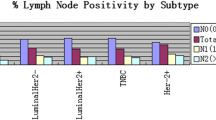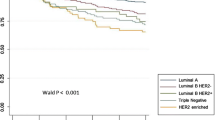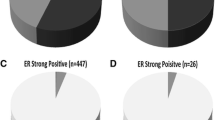Abstract
Background
Gene expression profiling of breast cancers identifies distinct molecular subtypes that affect prognosis. Our goal was to determine whether presenting features of tumors differ among molecular subtypes.
Methods
Subtypes were classified by immunohistochemical surrogates as luminal A (estrogen receptor [ER] and/or progesterone receptor [PR] positive, HER-2−), luminal B (ER and/or PR+, HER-2+), HER-2 (ER and PR−, HER-2+), or basal (ER, PR, HER-2−). Data were obtained from an established, registered database of patients with invasive breast cancer treated at our institution between January 1998 and June 2007. A total of 6,072 tumors were classifiable into molecular subtypes. The χ2 test, analysis of variance, and multivariate logistic regression analysis were used to determine associations between subtype and clinicopathologic variables.
Results
The distribution of subtypes was luminal A, 71%; luminal B, 8%; HER-2, 6%; and basal, 15%. Marked differences in age, tumor size, extent of lymph node involvement, nuclear grade, multicentric/multifocal disease, lymphovascular invasion (LVI), and extensive intraductal component were observed among subtypes. When compared with luminal A tumors, those overexpressing HER-2 (luminal B, HER-2) were significantly more likely to manifest nodal involvement, multifocal, extensive intraductal component, and LVI (P < 0.0001). On multivariate analysis, after controlling for patient age, tumor size, LVI, and nuclear grade, HER-2 subtype tumors were 2.0 times more likely to have four or more metastatic lymph nodes (P < 0.0001) and 1.6 times more likely to have multifocal disease (P < 0.0001) compared with patients with luminal A.
Conclusions
Tumor presentation varies among molecular subtypes; this information may be useful in selecting local therapy. Neoadjuvant therapy and lymph nodes evaluation before surgery or neoadjuvant therapy are likely to be beneficial in HER-2-overexpressing tumors.
Similar content being viewed by others
References
Perou CM, Sorlie T, Eisen MB, et al. Molecular portraits of human breast tumours. Nature. 2000;406(6797):747–52.
Sorlie T, Perou CM, Tibshirani R, et al. Gene expression patterns of breast carcinomas distinguish tumor subclasses with clinical implications. Proc Natl Acad Sci USA. 2001;98:10869–74.
Brenton JD, Carey LA, Ahmed AA, Caldas C. Molecular classification and molecular forecasting of breast cancer: ready for clinical application? J Clin Oncol. 2005;23:7350–60.
Sorlie T, Tibshirani R, Parker J, et al. Repeated observation of breast tumor subtypes in independent gene expression data sets. Proc Natl Acad Sci USA. 2003;100:8418–23.
Sotiriou C, Neo SY, McShane LM, et al. Breast cancer classification and prognosis based on gene expression profiles from a population-based study. Proc Natl Acad Sci USA. 2003;100:10393–8.
Nguyen PL, Taghian AG, Katz MS, et al. Breast cancer subtype approximated by estrogen receptor, progesterone receptor, and HER-2 is associated with local and distant recurrence after breast-conserving therapy. J Clin Oncol. 2008;26:2373–8.
Kyndi M, Overgaard M, Nielsen HM, et al. High local recurrence risk is not associated with large survival reduction after postmastectomy radiotherapy in high-risk breast cancer: a subgroup analysis of DBCG 82 b&c. Radiother Oncol. 2009;90:74–9.
Carey LA, Perou CM, Livasy CA, et al. Race, breast cancer subtypes, and survival in the Carolina Breast Cancer Study. JAMA. 2006;295:2492–502.
Piccart-Gebhart MJ, Procter M, Leyland-Jones B, et al. Trastuzumab after adjuvant chemotherapy in HER2-positive breast cancer. N Engl J Med. 2005;353:1659–72.
Romond EH, Perez EA, Bryant J, et al. Trastuzumab plus adjuvant chemotherapy for operable HER2-positive breast cancer. N Engl J Med. 2005;353:1673–84.
Crabb SJ, Cheang MC, Leung S, et al. Basal breast cancer molecular subtype predicts for lower incidence of axillary lymph node metastases in primary breast cancer. Clin Breast Cancer. 2008;8:249–56.
Morrow M, Schmidt R, Hassett C. Patient selection for breast conservation therapy with magnification mammography. Surgery. 1995;118:621–6.
Buzdar AU, Valero V, Ibrahim NK, et al. Neoadjuvant therapy with paclitaxel followed by 5-fluorouracil, epirubicin, and cyclophosphamide chemotherapy and concurrent trastuzumab in human epidermal growth factor receptor 2-positive operable breast cancer: an update of the initial randomized study population and data of additional patients treated with the same regimen. Clin Cancer Res. 2007;13:228–33
Acknowledgment
This study was supported by the Breast Cancer Alliance.
Author information
Authors and Affiliations
Corresponding author
Rights and permissions
About this article
Cite this article
Wiechmann, L., Sampson, M., Stempel, M. et al. Presenting Features of Breast Cancer Differ by Molecular Subtype. Ann Surg Oncol 16, 2705–2710 (2009). https://doi.org/10.1245/s10434-009-0606-2
Received:
Revised:
Accepted:
Published:
Issue Date:
DOI: https://doi.org/10.1245/s10434-009-0606-2




